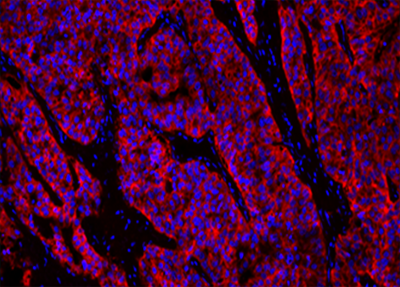
Do you have problems to detect low-abundance targets in cells and tissues?
Try AAT Bioquest Power Styramide Signal Amplification system!
Power Styramide™ Signal Amplification (PSA™) is a novel enzymatic amplification method used to detect low-abundance targets in cells and tissues.
By combining the superior brightness and photostability of iFluor® dyes with poly-HRP mediated styramide amplification,
PSA™ imaging generates bright fluorescence signals with significantly higher precision
and sensitivity (more than 100-fold greater) than conventional immunohistochemistry, immunocytochemistry, and in situ hybridization techniques.
Similar to tyramide signal amplification (TSA), PSA™ imaging uses the analyte-dependent reporter enzyme, horseradish peroxidase (HRP),
to catalyze the covalent deposition and binding of labeled-Styramide™ substrates onto a target protein or nucleic acid sequence in situ.
In the presence of hydrogen peroxide (H2O2), HRP converts labeled Styramide™ substrates into highly-reactive,
short-lived Styramide™ radicals that rapidly bind to tyrosine residues on and proximal to the enzyme site.
Styramide™ radicals have much higher reactivity than tyramide radicals, making imaging with PSA™ significantly faster, more robust, and sensitive than conventional TSA labeling.
Since the added labeled-Styramide™ are deposited close to the HRP-target site, there is a minimal diffusion-related loss of resolution.
PSA™ imaging technology can be readily added to any application that allows for integrating HRP into its protocol.
Such applications include IHC, ICC, IF, in situ hybridization, and ELISA.
Advantages of PSA™ Imaging System
Power Styramide™ signal amplification resulting from the rapid catalyzation and covalent deposition of multiple
Styramide™ substrates per HRP label translates to many practical benefits, including simplicity, enhanced sensitivity and specificity, and compatibility with other techniques.
The higher reactivity of Styramide™ radicals permits more robust and expeditious labeling of Styramide™
at the HRP-target interaction site resulting in stronger signal intensity and better spatial resolution than TSA.
Key Features of PSA™:
Ultra-sensitive detection of low-abundance targets, 100-fold greater than IHC, ICC, and IF methods
High fluorescence intensity, 10 to 50-fold greater than tyramide
Compatible with other fluorescent markers, staining techniques, and PSA™ imaging kits for multiplex analysis
Higher reactivity of PSA™ radicals for faster results and equivalent sensitivity and resolution versus radiometric detection
Conserve precious antibodies, PSA™ labeling achieves equivalent levels of sensitivity with a significant reduction in primary antibody
PSA™ imaging kits are easy-to-use and provide sufficient reagents for 100 tests
Flexible Workflow: compatible with IHC, ICC, ISH & flow cytometry
PSA™ imaging technology can be adapted to any application that supports the addition of HRP into its protocol
and is compatible with sample types and fluorescence imaging platforms commonly used in immunological applications.
When combined with conventional IHC, ICC, ISH, and FC applications, PSA™ imaging significantly
increases detection sensitivity without losing image resolution or increased background noise.

Take advantage of the current promotion: 20% off

DBA-ITALIA Srl
Via Umbria 10
20054 Segrate (Milano)
Tel. +39 02-26922300
If you no longer wish to receive these announcements
click here 


